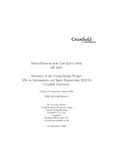- CERES Home
- →
- School of Engineering (SoE)
- →
- CoA. Reports
- →
- View Item
JavaScript is disabled for your browser. Some features of this site may not work without it.
| dc.contributor.author | Hobbs, Stephen | |
| dc.date.accessioned | 2010-09-21T14:04:58Z | |
| dc.date.available | 2010-09-21T14:04:58Z | |
| dc.date.issued | 2010-09-13 | |
| dc.identifier.citation | Stephen Hobbs, Debris removal from low earth orbit, College of Aeronautics Report 1001, September 2010 | en_UK |
| dc.identifier.issn | 9781907413049 | |
| dc.identifier.uri | http://dspace.lib.cranfield.ac.uk/handle/1826/4561 | |
| dc.description.abstract | Students of the MSc course in Astronautics and Space Engineering 2009/10 at Cranfield University studied a low Earth orbit (LEO) debris removal mission for their group project. The mission's name was DR LEO (Debris Removal from LEO) and its aim was to develop a credible mission baseline using conventional technology to perform active debris removal from LEO. This report summarises the students' work and their findings. The report consists of an overview and discussion of the technical work of the project and a compilation of the executive summaries which describe the specific contributions of each student. The baseline mission design developed is broadly credible and provides a useful benchmark against which other missions can be compared to evaluate the potential of alternative technologies. The mission costing from this first design iteration sets a benchmark cost per unit mass de-orbited of approximately € 20-30k kg - 1 using conventional chemical propulsion. | en_UK |
| dc.language.iso | en | en_UK |
| dc.publisher | Cranfield University | en_UK |
| dc.relation.ispartofseries | College of Aeronautics Report;1001 | en_UK |
| dc.relation.ispartofseries | CU/CoA;1001 | en_UK |
| dc.rights | Copyright Cranfield University 2010. All rights reserved. No part of this publication may be reproduced without the written permission of the copyright holder. | |
| dc.title | Debris removal from low earth orbit (DR LEO) | en_UK |
| dc.type | Report | en_UK |
Files in this item
This item appears in the following Collection(s)
-
CoA. Reports [280]
